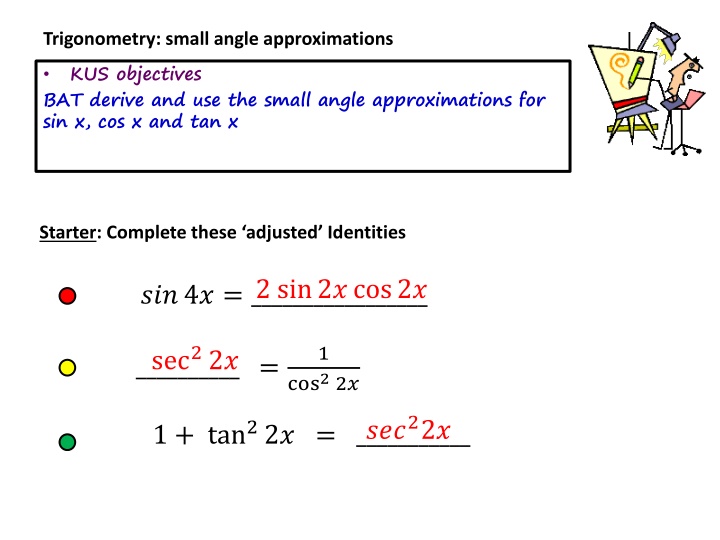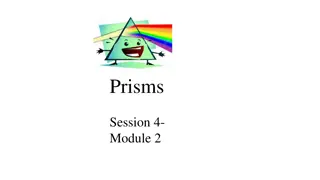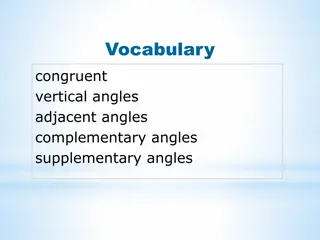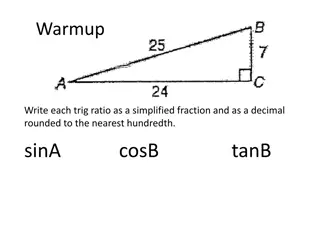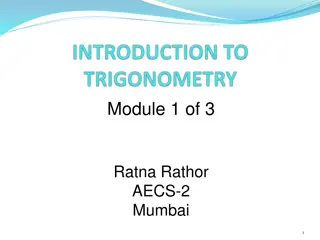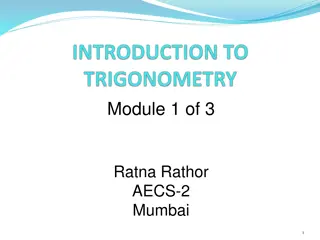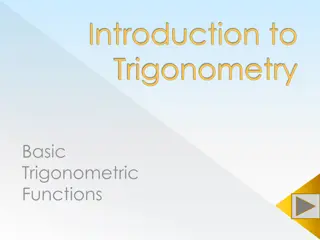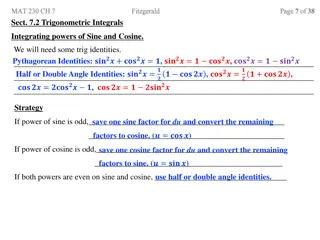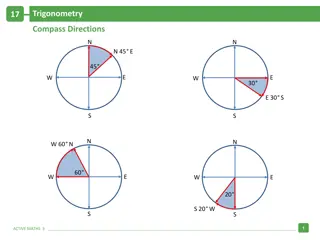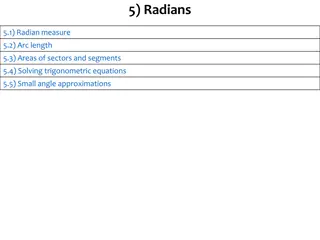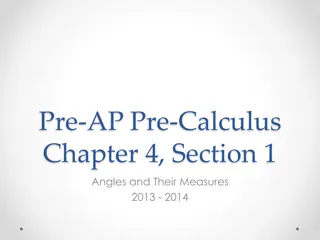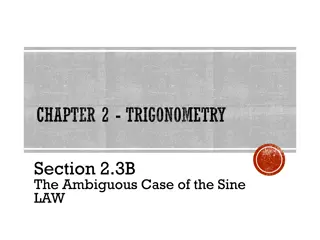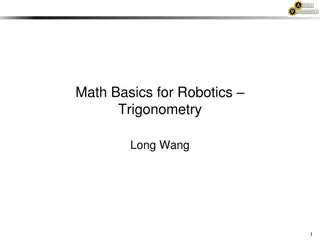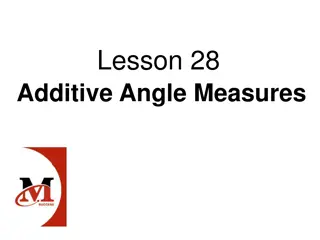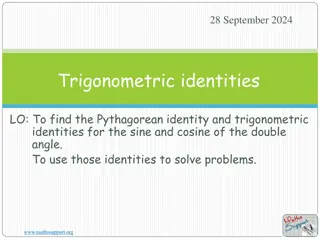Trigonometry Small Angle Approximations and Identities
Delve into the use of small angle approximations in trigonometry, deriving and applying identities for sine, cosine, and tangent functions. Understand the significance of small angles in accurate calculations and explore the practical applications in physics fields. Discover adjusted trigonometric identities, double angle identities, and how to evaluate trigonometric functions with minimal error using these approximations.
Download Presentation

Please find below an Image/Link to download the presentation.
The content on the website is provided AS IS for your information and personal use only. It may not be sold, licensed, or shared on other websites without obtaining consent from the author.If you encounter any issues during the download, it is possible that the publisher has removed the file from their server.
You are allowed to download the files provided on this website for personal or commercial use, subject to the condition that they are used lawfully. All files are the property of their respective owners.
The content on the website is provided AS IS for your information and personal use only. It may not be sold, licensed, or shared on other websites without obtaining consent from the author.
E N D
Presentation Transcript
Trigonometry: small angle approximations KUS objectives BAT derive and use the small angle approximations for sin x, cos x and tan x Starter: Complete these adjusted Identities ???4? = _________________ 2 sin2? cos2? __________= sec22? 1 cos22? ???22? 1 + tan22? = ___________
WB75 Deriving the small angle approximations As long as the angle is sufficiently small, the length of arc s (the arc subtended by ) is very close to that of s The third side of the triangle. The small angle approximation corresponds to s s in this diagram The sin rule gives ? ? ? = ?sin? sin?= sin90 From radians work Arc length = ? ? If s s then we get ? ????
WB75 Graph of small angles for sin x and tan x (radians) ???? ? ?.??~?? ???? ? For small angles the difference between x and sin x OR x and tan x is negligible ?.??~??
WB75 Deriving the small angle approximations A double angle identity for cos is cos2? = 1 2sin2? An alternate version is cos? = 1 2sin2? 2 2 ? 2 1 2 1 ?2 Note this is 1 since is small 2
WB75 Graph of small angles for cos x (radians) ???? ? ?? ? ?.??~?? For small angles the difference between ? ?? ? and cos x is negligible
WB75 Summary small angle approximations In the formula booklet you are given The small-angle approximation is used ubiquitously throughout fields of physics including mechanics, waves and optics, electromagnetism, astronomy, look it up on Wickipedia for more The main application of this in A level is with proof from first principles of the derivatives of sin x and cos x.
???? ? ???? ? ?? ???? ? WB76 evaluate your answers to with those given by your calculator Find a approximation to each of the following and compare / ? c) tan? b) cos? a) sin? 12 ? 12 12 12 ? 12 2 ? 12 = = 1 = = 0.262 = 0.966 = 0.262 Calculator = 0.218 = 0.966 Pretty close! = 0.259 e) cos 10 f) tan10 d) sin 10 tan? ? 18 2 sin? ? 18 cos? ? 12 18= 18= 18= 1 = 0.995 = 0.175 = 0.175 Calculator = 0.985 = 0.176 Pretty close! = 0.174
???? ? ???? ? ?? ???? ? WB77 tan functions and their small angle approximations Use the spreadsheet set up for you Investigate the percentage error between each of sin cos and ?
? 20 ???? ? ???? ? ?? ???? ? Find a small angle approximation for sin 2 when = Give an exact answer WB78 ? sin 2 = 2sin cos Using trig identity 1 2 2 2 ?2 400 ? 20 1 1 2 2 1 ?2 ?3 ? 10 ? 10 = 800 8000
???? ? ???? ? ?? ???? ? WB79 the following a) sin2 cos b) sin cos2 c) sin2 +1 Find an expression for the small angle approximation of ? d) sec2 e) ?????2 cos 2= 2 1 a) sin2 cos = 2 . 1 2 2 4 = ? 1 ?2+?4 = ? ?3+?5 2 ?) sin cos2 = ? . 1 2 4 4 2 =2 2+ 2 2 2 sin2 + 1 cos = 2+ 1 1 2 ?) 2 2 1 1 ?) sec2 = = 1 2 1 ?2+?4 2 4 1 2 ?) ?????2? =
WB80a Find the small-angle approximation to sec ? tan ??????2? cot2? ???? ? ???? ? ?? ???? ? As a polynomial in terms of x ? You might do this 2 2 ? 1 ?2 1 ? sec?tan? ?????2? cot2? BUT this looks like a lot of work to simplify! 2 2 1 ?2 /?2 2 Is there another way to start the question?
WB80b Find the small-angle approximation to sec ? tan ??????2? cot2? ???? ? ???? ? ?? ???? ? As a polynomial in terms of x If we try and simplify the expression in Trig terms first ? cos?.sin? 1 1 cos? cos2? sin2? sec?tan? ?????2? cot2? sin3? cos2? cos2?sin2? .sin2? cos2? sin2? = = =sin3? cos2? sin4? 2 ?3 1 ?2 ?3 1 ?2+?4 Now use the approximations 2 4 = ?4 ?4 = ? 1 ? 4 ? 2+1 4 OR =? ?+ ? ? ? ? ? ?
KUS objectives BAT derive and use the small angle approximations for sin x, cos x and tan x self-assess using: R / A / G I am now able to ____ . To improve I need to be able to ____
